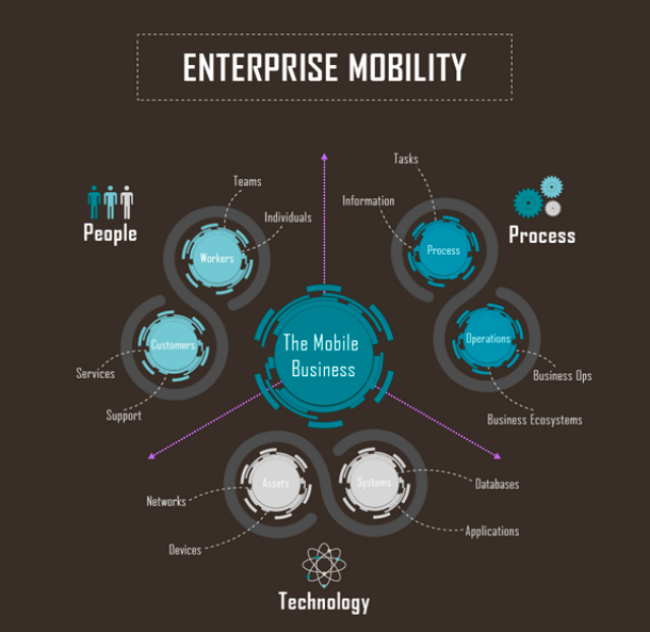Mobility has changed our way to live, work, and play. We are so much dependent on our smartphone to get instant answer. We have headed to an event at least for once in our life while turning the Google Maps on because of unknown location. We capture very first great moments of our child with phone camera. Android developers India have made it so easy for everyone!
For the past decade, most businesses chosen a “ready, fire, aim” approach for deployment of mobile technologies. Companies are readily investing their time and resources in defining a mobile strategy. This allows them to evolve.
On an average, enterprise apps take between 8 and 18 weeks to accomplish. In 2015, there were more than 1.3 billion mobile workers worldwide.
Let’s discuss now where we are heading in enterprise mobility.
- Mobile growth is booming
As per the report, nearly six of the seven billion people across the world now have their mobile phones. Customers and workers alike are untethered, which is allowing new business models and evolving industries. Take an instance of SnapChat, Facebook, or Uber, where 400 million of their users log in with their mobile devices. In Simple words, mobility is a primary way to communicate and get jobs done.
- User convenience wins everything
As per the report, one in four mobile apps is downloaded by users once and is never used again. This revealed that a high percentage of apps could not meet the expectations. It depends on app developers how do they innovate and if they fail, users will simply delete the apps and stop using them. Companies and users want and expect immediate benefit from the mobile experience.
- The gap of digital talent gets wider
Businesses are turning into software businesses, i.e. the competition for software talent is now intense. Skilled developers are expensive and experts predict that the talent shortage will become more pronounced as more companies advance their efforts towards digital transformation across core infrastructure, cloud migration, application modernization, and management.
Hiring android developers in India can be a competitive practice for companies. Every organization needs to prioritize what development can be outsourced, what can be handled by native developers, and what projects need proficient skilled in-house development teams to address a talent gap.
- Quality experience matters more than anything
Beyond the feel and looks, users expect mobile apps to be intuitive, available, and provide the precise content. Users want faster apps with no-time single login facility. If the app could not meet the expectations of the user, it will be ignored or uninstalled.
- Wearables are the trendsetter in 2017
According to the latest reports, more than 90 million wearable units are brought by users across the world. Better defined use cases inside the enterprise organizations is one of the factors that contributes to the growth of wearables. Job fields like healthcare, manufacturing, military, and field services have begun to benefit from wearables such as watches, glasses, and body cameras.
- Companies are embracing mobile apps
Around 35% of large enterprises will create and distribute mobile apps within. Along with the right content, apps require the right context. Android developers now understand that integration with back-end systems is now a necessity. If any user visits a website and puts items in his shopping cart, he would expect his mobile app to have that same shopping cart details in order to place his order whenever he wants to.
When it comes to integrating customer-facing apps, IT experts often encounter a complex, time-taking, and costly task.
- More APIs for boosting innovation
Android developers need to do rapid development across a variety of target devices and mediums. An API-first approach ensures flexibility along with agility. Android mobile app developers are released from stress of data storage and getting systems of record by leveraging a catalog of mobile REST/JSON APIs. This accelerates innovation in mobility.
- Developers need to balance both security and user experience
People are living personal and professional life and they don’t want others to access their personal or official data through their mobiles. Developers are considering the both security and user experience. As long as user can freely access his mobile device to perform his routine activities, he doesn’t mind if there is added security around his corporate apps and data.
- Cloud technology facilitates mobile development
Every business department wants to innovate accordingly, while the teams of IT experts want the features and tools that help integration and speed development. So, the cloud technology enters and intersects with mobile development to streamline user security, back-end integration, and management.
- “Mobile first” turns into “mobile plus” strategy
Android developers India understand the need of developing a mobile strategy that brings together enterprise mobility, the IoT, and cloud. Today, we are using smartphone as our personal phone, computer, entertainment center, camera, map, shopping guide personal trainer, and more. If you imagine yourself without your smartphone, you will get the idea about the life within minutes.
You can forget your wallet at home while dining out and it won’t be a big trouble because you can pay with your smartphone!
In this post, we have talked about the mobility trends and facts. If you have something to say about the post, write in comments. We are reading them! Share your thoughts with other readers and gossip more about the trendsetters in mobile world.
